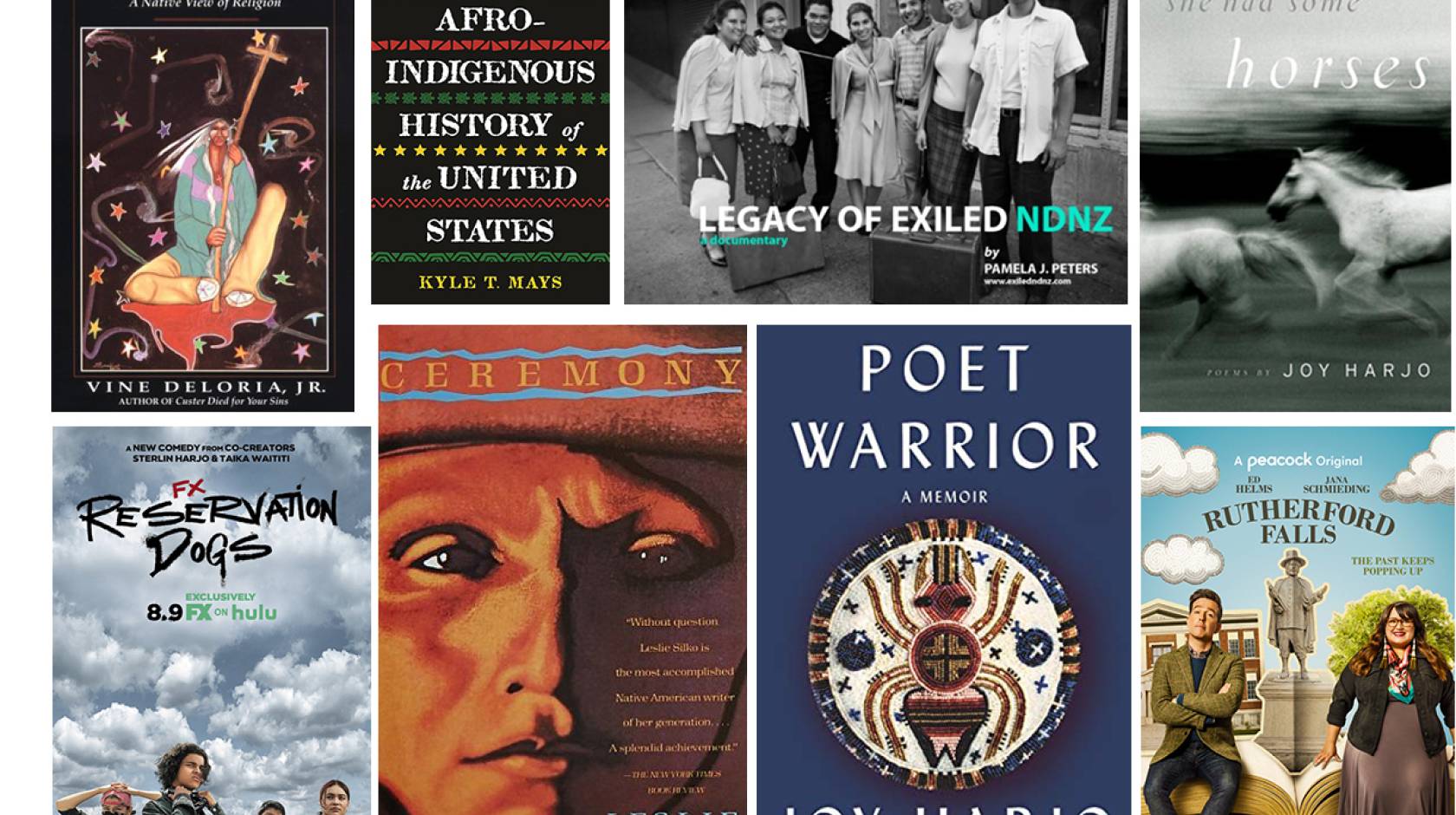UCLA Newsroom

Since it was first launched by presidential proclamation in 1990, Native American Heritage Month has been an occasion to celebrate the diverse cultures, histories and traditions of the Indigenous peoples of North America and to recognize their vital contributions to the U.S. and beyond.
Newsroom reached out to staff members across campus for their recommendations on what to read, listen to and watch to help mark the month. Their picks — from poems and novels to TV shows, films and podcasts — paint a wide-ranging picture of Native experience that not only touches on the long and brutal legacy of racist government policies and genocide but also testifies to the perseverance, vibrancy and ongoing creativity of Native communities and artists.
Such a list could never be complete, but we hope it will serve as an introduction and a jumping-off point for further discovery.
Libby O’Kane, events and visitor services manager, Fowler Museum at UCLA:
-
Watch: “Rutherford Falls” is a smart, funny TV show that uses comedy to address important issues in cultural-heritage ownership between history museums and Native Americans.
Eric Greene, associate director for diversity and campus climate, Strategic Communications:
-
Watch: “Reservation Dogs,” a fictional TV series that follows four Native teens in Oklahoma, is now in its second season. Tazbah Rose Chavez, who has written, directed and produced episodes of the show, and who has also been a writer, director and story editor on “Rutherford Falls,” holds a degree in American Indian studies from UCLA!
-
Read: Works by poet, author, playwright and musician Joy Harjo, who served three terms as the 23rd Poet Laureate of the United States. Also, books by UCLA faculty members Kyle Mays (“An Afro-Indigenous History of the United States”), Carole Goldberg (“A Coalition of Lineages”) and Ben Madley (“An American Genocide”).
Sandra Shagat, director, Development Marketing:
-
Read: Many of these works by Native authors are considered foundational to people in my age group. If you don’t know them, I promise you won’t regret getting acquainted with them. Among them are “Bone Dance” and “Now Poof She Is Gone” by Wendy Rose, “This Is What It Means to Say Phoenix, Arizona” by Sherman Alexie, and “The Beet Queen” and “Tracks” by Louise Erdrich.
-
Watch: “Smoke Signals,” based on Sherman Alexie’s book, and the Canadian horror movie “Blood Quantum,” about a zombie uprising on a First Nation reserve.
Mike Dirda, director of executive and internal communications, Strategic Communications:
-
Read: “There There” by Tommy Orange is a beautifully written book that uses a series of different narrative techniques and styles to survey Native American experiences and histories, look into questions about identity, and examine some of the modern struggles of Native peoples.
Jessica Wolf, senior media relations representative, Strategic Communications:
-
Read: “The Grass Dancer” is a powerful work of magical realism by Susan Power set on a North Dakota reservation and told from multiple perspectives and across generations. In “The Trickster Trilogy,” Eden Robinson, an Indigenous author from British Columbia, spins a delightfully creepy and slightly heartbreaking story about a teenage boy with a rough family life coming to terms with the supernatural within and around him.
-
“How a Mountain Was Made: Stories” by UCLA alumnus and former English professor Greg Sarris invites the reader to imagine the making of the world through the creation stories of traditional Coast Miwok and Southern Pomo peoples, the inhabitants of the Sonoma Mountain area. “They’re fun, they’re easy to read, but they contain morals and ethics about how to live in this world, which is what our stories always did,” Sarris told UCLA Newsroom. “Our stories remind us to live, if I may say so, responsibly on the Earth.”
-
Watch: “Water Flows Together.” This powerful, meditative documentary follows Colleen Cooley, a San Juan River guide, through the traditional lands of the Diné, Hopi, Ute and Zuni peoples. It inspires important ruminations: Where does your water come from? Do you realize how many people struggle with access to it? What will you do to help preserve and protect this resource that no living creature or the planet can survive without?
Dennis Pacheco, senior director of diversity programs and initiatives, Alumni Affairs:
-
Read: “God Is Red” and “Custer Died for Your Sins” by Vine Deloria Jr. and “Ceremony” by Leslie Marmon Silko are foundational texts that have helped to shape the landscape of ethnic studies and Native American studies. I believe that reading these kinds of texts is a critical way for non-Native people to learn more about non-dominant ways of viewing the world, which can foster greater understanding and allyship.
-
And these resources provide important insight into the wide range of experiences of Native peoples today: “Bad Indians” by Deborah Miranda, which was a finalist for the UCLA Common Book in previous years; Miranda’s article “Lying to Children About the California Missions and the Indians”; and the story maps from the UCLA Mapping Indigenous LA project.
-
Watch: Pamela J. Peters is a Bruin, artist and documentarian of the Diné (Navajo) nation who made a great a documentary called “Legacy of Exiled NDNZ.” The UCLA American Indian Studies Center has some fantastic videos of online events they’ve recently presented. The center will also be hosting an upcoming Native Film Festival.
Filmmaker and multimedia artist Pamela J. Peters, operations and events coordinator, UCLA American Indian Studies Center:
-
Listen: “Native America Calling” is a live call-in radio program and podcast featuring thought-provoking conversations about issues important to Native communities. “The Cuts With Sterlin Harjo” is a podcast in which award-winning filmmaker Harjo, who is the executive producer, director and co-writer of “Reservation Dogs,” interviews friends and fellow artists and shines a light on Native artists. And the podcast “Well for Culture” focuses on food, health and mental well-being as part of a larger initiative to reclaim and revitalize Indigenous health and wellness.
Sebastian Hernandez, manager, UCLA Broadcast Studio:
-
Watch: “The Other Mexicans” Indigenous Zapotec and Mixtec people from Oaxaca, Mexico, are often grouped with other Mexicans when they arrive in the U.S., resulting in an erasure of Indigenous Mexicans in the census and in the public understanding. Complex, divergent histories and cultural practices get reduced to one national label. This documentary is a beautiful depiction of several Indigenous groups, their way of speaking, caring, art making and celebrating. It is unlikely you’ve seen a portrayal of Indigenous people quite like this.
Shantel Broadhead, writer and editor, Stategic Communications:
-
Watch: Indigenous People Answer Commonly Googled Questions About Native Americans. This Buzzfeed video is a really dope way that Native people have shared information and education via YouTube.
Todd Schindler, senior editor, UCLA Newsroom:
-
Watch: “Rumble: The Indians who Rocked the World” highlights the seminal and often overlooked contributions of Native musicians to blues, rock, jazz, soul and nearly every other form of American music. And the documentary “Mankiller” tells the fascinating story of Wilma Mankiller, the first woman principal chief of the Cherokee Nation in Oklahoma.
-
Listen: John Trudell was a Native poet, author, actor, activist and longtime chairman of the American Indian Movement. He was also a spoken word artist and musician. His “Blue Indians” album, from 1999, has always been one of my favorites.

